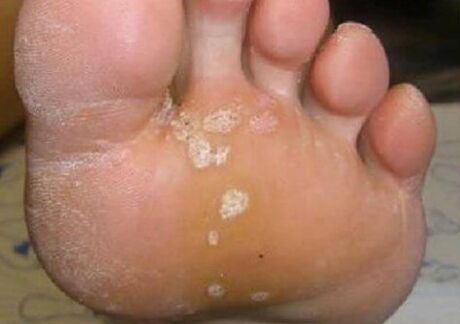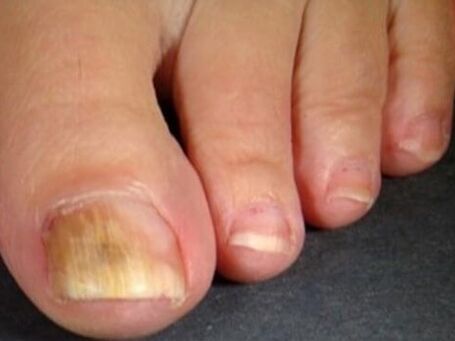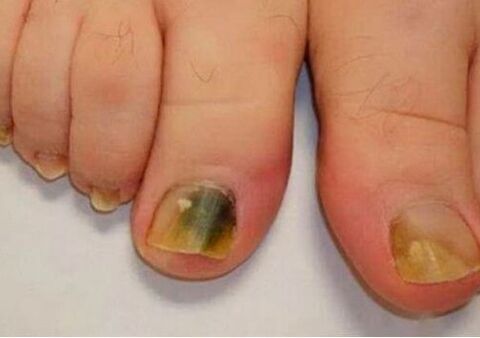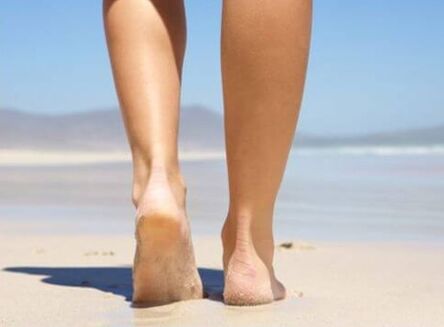Redness, skin peeling, the appearance of cracks between your fingers, chiefs in the nails: Loss of gloss, common pink shade, thickening boards and other signs indicate the development of a fungal infection. Each fifth resident of the ground is ill with Mikozo. Therefore, you need to know how the fungus looks and behaves on your feet, which causes its appearance and how to treat this unpleasant disease.

Reasons
In most cases, mikoze infection comes from a person to a person directly or through the surrounding objects. Favorable conditions for fungus reproduction are fever, moisture. Disputes can also maintain sustainability in dried condition, after poor manicure tool processing.
The main reasons for the disease include:
- Lack of careful feet care.
- Accommodation with a person suffering from fungi.
- Using someone else's shoes, socks.
- Stop injury.
- Visit of the "mushroom" common area (beaches, baths, swimming pools).
- Insufficient processing of pedicure supplements.
- Wearing tight shoes from synthetic materials.
- Professional harmfulness (work in high temperature and humidity conditions).
- Shooting shoes in a trade without socks or squads.
Fungal diseases in humans are developing faster in the background of the functioning characteristics, as well as changes that lead to immunity combat, impaired local circulations, changes in skin condition. The reasons from the body are as follows:
- Endocrine pathology (diabetes, obesity);
- pregnancy;
- Immunodeficiency;
- Increased sweat;
- foot diseases;
- Vascular disorders;
- Chronic skin diseases (eczema, psoriasis);
- Long-term intake of drugs that control immunity (corticosteroids, cytostatics).
Types of pathogenic mushrooms
Fungi on the human body Food is protein - Keratin, Elastin, Collagen, share them with enzymes: keratinase. The localization of mycosis depends on the activity of keratinase and the ability to digest different types of keratin.
Mycosis on your feet cause the following types of fungi:
- Trichophyton Rubum - type of fungus-saprophytes that bite the keratinized layer of the skin. Causes cutting lichens, epidermis damage, nails in 80% of cases.
- Trichophyton Mentegraphes causes the epidermophies to stop.
- Trichophyton Interdigitale. On his feet, mushrooms causes dermatophytosis, onychomicosis.
- The mushrooms of the genus Candida affect the skin and nail plates with heavy immunity falls affect the skin and nail plates with severe immunity falls.
Funting skin lesions

From mycosis on your feet, skin lesion during psoriasis (sometimes called dry fungus) - red peels with peeling and tendency to merge above the surface. Such elements are often found on the knees, legs. This disease is not related to the Gjivić infection.
The fifth manifestations are conditionally divided into four main forms. The Convention is in a combination of clinical signs and the possibility of moving from one to another.
In each other's form of skin it is suffered in intermediate spaces. Mushrooms of the legs are manifested in the form of itchy type, ignition, accompanied by an unpleasant odor. Often the infection affects the foot from the interval between 3 and 4, 4 and 5 fingers. The skin becomes red, impregnated with moisture, ulcers, the canvas areas between the fingers appear. These signs develop independently or against the background of an existing stretchable shape.
Note! For an interpriginous lesion, a typical, contribution of a secondary bacterial infection that worsens the disease. Bacterial, mycotic eczema is developing with the formation of rashes not only on foot, inflammatory elements appear on the ankle, descending.
Advanced skilled hypercheralatotic form looks like a common, massive corn on the folding with cracks. In the beginning of micosa skin legs can attract attention with dry, skin peeling, limited gross corn on the heels. People believe that such symptoms are single characteristic and do not rotate a dermatologist. Lesions of the skin can follow itch, ignition. If you look at the photos of fungus on your feet with this form of mycosis, you can notice deep cracks on the background thickened (and, as it was, stabbed in moccasins) skin foot. Such are painful manifestations. Squamous form is characterized by the inclusion of nail plates with its destruction, lag behind the nail bed.
The manifestations of the dishydrotic (interconnection) form of the feet of mushrooms are rarely. The main symptom of the disease is the formation of bubbles with thick shell and transparent content. They are localized on the only side of the foot, fingers as single or drain formation. Then the bubbles open up with the formation of erosion with a purulent bark around the edges. Complications of vesicular lesions include:
- Toxic allergic reactions. They develop 4-6 days, often localized symmetrical: swollen reddish papules can be found on the foot, lower leg, forearm, facial, mucous membranes.
- Connecting a secondary bacterial or viral infection with eczema development.

The deleted form of fungus on the legs characterizes the minimum lesions, so it is not easy to recognize it. Main signs: The appearance of flower peeling, forming microcracks between fingers, discomfort, ignition. The long exchange rate includes nail plates.
Fungus nail
Onychomicosis appears as a result of the leather fungus on the fingers, feet, in the absence of attention to the problem and adequate treatment.
The first symptoms and signs of onikmicomize can also pass unnoticed. You should contact your fingernail fungal on your feet and contact a dermatologist at:
- Change of colored nail plate;
- the appearance of yellow or greyhound point;
- Loss of gloss;
- appearance on the surface of irregularities;
- strips in the nail structure;
- Increased radiance.
There are different classifications of the micromicosis. According to the appearance of the nail plate are divided into:
- Normotrophic. A fungal infection changes color to nail on yellowish gray, thickness and shape remain the same.
- Hypertrophic. This type of fungus is characterized by gross changes: nails are yellow, thickening. If you look at the photos showing this type of onyhomycosis, you can notice a characteristic plate shape. Transverse studies, loosening and babysits in the free edge are visible. Such a change in nail leads to their growth. Walking becomes painful.
- Onycholitic. Nailboards are becoming thinner, change color, distort from the nail bed.
According to localization and degree of nail damage, the following types of ONY micromicosis are characterized: distal; side; mixed, proximal; total; Area.
Defeat of candidiasis
Separately, damage to the mushrooms of the genus Candid should be considered. These conditionally pathogenic mushrooms cause deep (affecting internal organs) and micosa surfaces (dermatomicosis, onanicmicosis). Under normal conditions, human immunity suppresses the reproduction of this fungus and the mass infection does not occur. Therefore, the Candida activity is manifested by significant disruptions in the body protection and requires a thorough examination for the establishment of the cause of immunodeficiency. The first signs of infection are difficult to distinguish from injuries, frostbite.

Fungal leg damage is developing as follows:
- On the fingers of the leg there is an inflammation of nail rolls with redness, swelling, leather cracks, the appearance of discomfort in any movement. A blasted whitish shade is formed under the nail plobes.
- Inflammatory changes in the skin fall, the disease becomes chronic. The skin around the nail thickens, stops grow. Infection affects nail plates.
- Foot nails begin to thicken, sprinkle. Their color becomes brown, brown. Breach of blood supply leads to rejection.
Diagnostics
The diagnosis of the fungus on the legs includes:
- Talking with the patient (complaints, accompanying diseases, working conditions, clarification of infection capabilities).
- Inspection.
- Laboratory research methods (scraping leather, nails with microscopy, sowing dedicated crops with determination of drug sensitivity, ig g for Aspergille, candidates).
Treatment
Foot mushroom requires currently treatment to prescribe a dermatologist (or mycologist). You can perform tasks on an ambulance basis.
How and how to treat the fungus on your feet depends on the series of conditions:
- Localization of the pathological process;
- degree, severity of defeat;
- presence of concurrent diseases;
- Patient's age;
- In cases of women's therapies - the fact of pregnancy, breastfeeding.
Treatment of fungus on feet lasts a lot of time and its main goal is the disappearance of clinical and laboratory signs of infection. The incomplete therapy course leads to relapse disease.
Drug therapy
Drug treatment is performed using antifungal drugs that do not only destroy mycos, but also helping to remove the inflammation manifestations and eliminate secondary infection.
Are divided into:
- Local. Apply to lesion (ointment, gel, cream, spray, varnish, solution).
- System - Take orally (tablets, capsules, solutions).
In the initial phase of a fungal infection, medicine therapy is limited to the appointment of local means. With shared micosom, with a difficult course, the connection of systemic antimocytics is needed.
Treatment to folk drugs.
There is a lot of recommendation on how to get rid of the fungi on the legs of folk and domestic remedies. Most means external use, and some - inwards. However, you should not drink and apply suspicious compositions into your legs in hopes you will bring neglected mycos. Such folk methods can harm health.

Note! The most common and more efficient home remedy for fungus are leg legs with salt, sodom, essential oils. These therapeutic procedures are preparing feet and nails for the application of medications.
Surgical treatment
With mass damage to the fungal, nail plates must be removed. This method is safe and practically no contraindications. Alternative to surgical manipulation - use of paste and fat to soften the nails followed by removing.
Laser treatment
The use of an anti-attack laser is based on heating and destroying the slow fungus with the direction of the beam. This technique allows you to heal you quickly onychomicosis, safe and applicable in patients who are contraindicated in system treatment.
Treatment of dermatomicosis
To start a fungus treatment, local antifungal agents are used on their feet. If after 2 weeks of treatment stream, there is no improvement in a state, an antimatic agent is required. In case of heavy damage, skin fungus requires prescribing systemic drugs. Therapy continues to the full elimination of infection.
Treatment ofychomicosis
To remove the initial nail fungus manifestations, local medications are prescribed. Mikoza from the lesion more than 2/3 of the nail area, including growth zone, distribution to other plates - an indication for taking system medicines. OnihyComyCosis with mass destruction of nail panels starts to be treated with surgical removal of affected nail tissues. This method provides access to the focus of the infection.
Important!
The treatment of ONY micromiquites is done before the growth of healthy nails and can last up to 12 months.
The appearance of the fungus on the legs can be caused by various reasons. A careful attitude towards your health will help will recognize disease in time and start treatment.



























